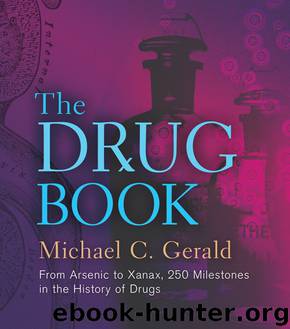The Drug Book by Michael C. Gerald

Author:Michael C. Gerald
Language: eng
Format: epub
Tags: ebook, book
Publisher: Sterling
Published: 2012-12-11T16:00:00+00:00
Mercaptopurine
1953
George H. Hitchings (1905–1998), Gertrude B. Elion (1918–1999)
One of the great collaborations in science led to the development of highly significant and innovative drugs used for the treatment of cancer, bacterial and viral infections, malaria, and gout, as well as to prevent the rejection of transplanted organs. For these accomplishments, George Hitchings and Gertrude Elion were awarded the Nobel Prize in Physiology or Medicine in 1988.
In 1942, Elion joined Hitchings’s laboratory at Burroughs Wellcome in Tuckahoe, New York (now GlaxoSmithKline in Research Triangle Park, North Carolina). Hitchings had earned a doctorate in chemistry at Harvard; Elion had a master’s degree, but financial pressures prevented her from completing a PhD program. Over the years, Elion’s career rapidly progressed from Hitchings’s assistant to a fully equal collaborator.
TRICKING CANCER CELLS WITH COUNTERFEIT BUILDING BLOCKS. Studies by Hitchings and Elion focused on chemical modifications of natural purines and pyrimidines, building blocks in DNA synthesis. The development of their chemotherapeutic agents—medicines used to combat bacteria, viruses, and cancer—was based on the use of antimetabolite drugs. Antimetabolites are false building blocks that insert themselves into biochemical reactions. Once there, they substitute themselves for the normal purine or pyrimidine building block (the metabolite) used in the microbial or cancer cell; and because the cell cannot utilize them to synthesize DNA, the cell cannot divide and grow.
Hitchings and Elion’s first significant drug was 6-mercaptopurine (Purinethol), a purine antimetabolite that Elion synthesized in 1950. It was further evaluated in New York City at the Sloan-Kettering Institute and then clinically tested at Memorial Hospital. Mercaptopurine produced complete remissions of leukemia in children, but these victories were temporary and followed by relapses within one year. Later, with a better understanding of the biology of the cell and cancer chemotherapy, other clinicians began to treat leukemias with mercaptopurine as a component of a combination of drugs. Leukemia cure rates now approach 80 percent.
SEE ALSO Sulfanilamide (1936), Amethopterin and Methotrexate (1947), Zyloprim (1966), Acyclovir (1982).
Download
This site does not store any files on its server. We only index and link to content provided by other sites. Please contact the content providers to delete copyright contents if any and email us, we'll remove relevant links or contents immediately.
| Administration & Medicine Economics | Allied Health Professions |
| Basic Sciences | Dentistry |
| History | Medical Informatics |
| Medicine | Nursing |
| Pharmacology | Psychology |
| Research | Veterinary Medicine |
The Poisoner's Handbook by Deborah Blum(2093)
Bottle of Lies by Katherine Eban(1763)
Mycelium Running: How Mushrooms Can Help Save the World by Paul Stamets(1642)
The Vaccine Race by Meredith Wadman(1629)
Missing Microbes by Martin Blaser(1553)
The Doors of Perception and Heaven and Hell by Aldous Huxley & Aldous Huxley(1549)
Pharmacy Practice and The Law by Richard Abood(1543)
Decisive by Chip Heath(1518)
28 Seconds by Michael Bryant(1485)
Steroids: History, Science, and Issues by Standora Joan E.; Bogomolnik Alex; Slugocki Malgorzata(1480)
McGraw-Hill Nurses Drug Handbook by Patricia Schull(1466)
The Doors of Perception: Heaven and Hell (thINKing Classics) by Aldous Huxley(1450)
Ganja Yoga by Dee Dussault(1425)
What's Making Our Children Sick? by Michelle Perro(1384)
Complete Guide to Prescription & Nonprescription Drugs 2014 by H. Winter Griffith(1329)
Stealing Fire: How Silicon Valley, the Navy SEALs, and Maverick Scientists Are Revolutionizing the Way We Live and Work by Steven Kotler & Jamie Wheal(1310)
Anatomy of an Epidemic by Robert Whitaker(1292)
Trip by Tao Lin(1264)
Cannabis for Chronic Pain by Rav Ivker(1201)
